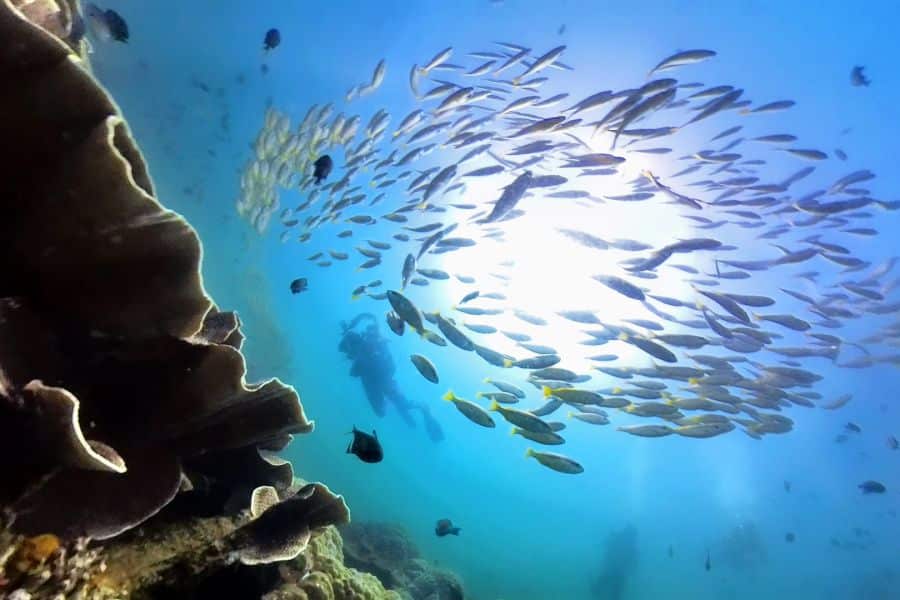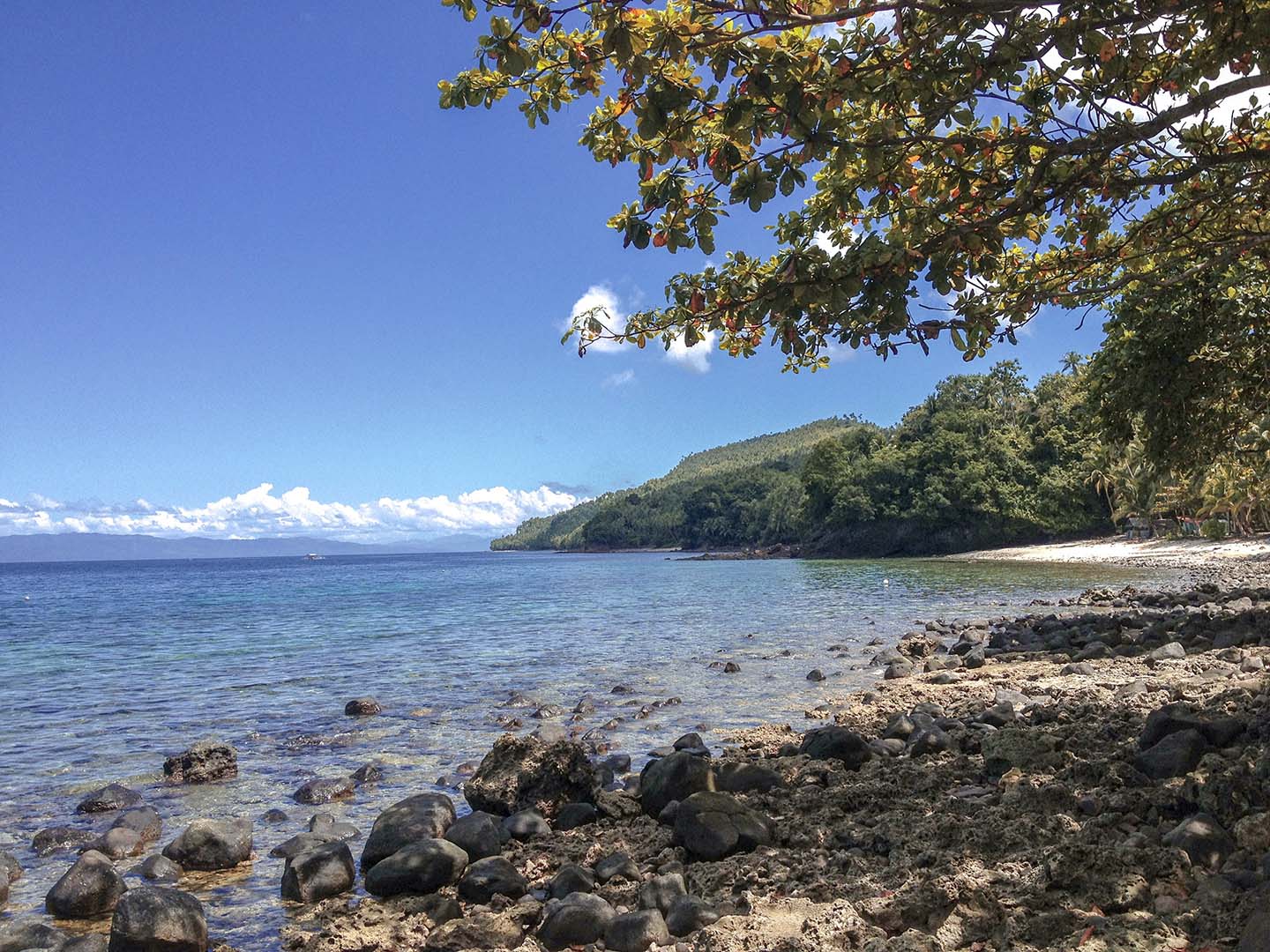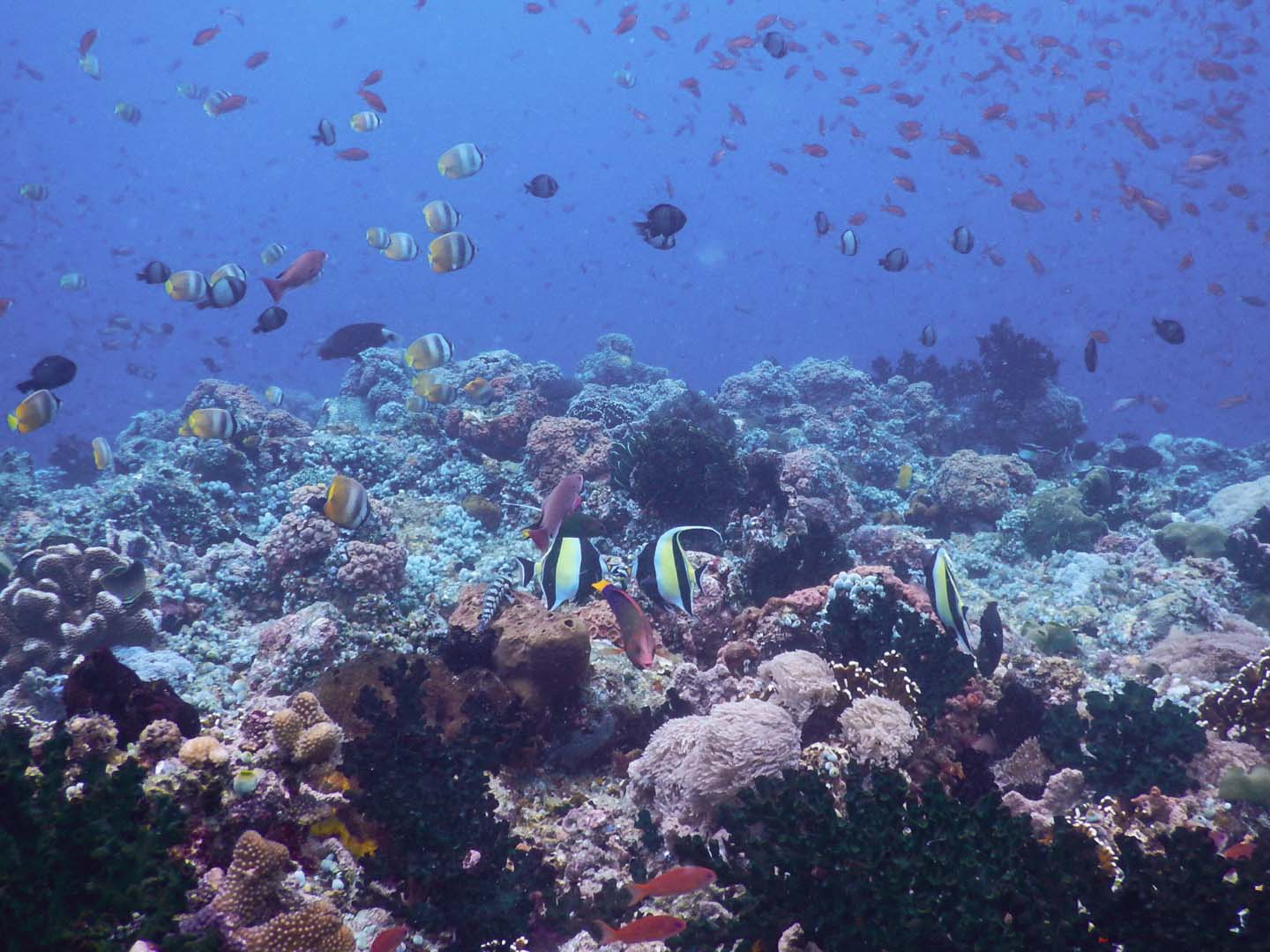El Nido, located in the picturesque province of Palawan, Philippines, is a tropical paradise renowned for its breathtaking natural beauty both above and below the surface. With its crystal-clear turquoise waters, towering limestone cliffs, and vibrant coral reefs, El Nido offers an exceptional scuba diving experience that attracts divers from around the world.
Diving in El Nido is an opportunity to explore an underwater wonderland brimming with marine biodiversity. The region boasts a plethora of dive sites, each with its own unique features and marine life encounters. From magnificent coral gardens teeming with colorful fish to thrilling swim-throughs and captivating tunnels, El Nido has something to offer divers of all levels of experience.
As a recent visitor to Palawan, I am thrilled to share my first-hand experience of scuba diving in El Nido.
Whether you’re a seasoned diver or a curious beginner, this post will serve as your go-to resource for diving in El Nido, ensuring you make the most of your underwater explorations in this captivating destination.
El Nido is a breathtaking destination located on the northernmost tip of Palawan island in the Philippines. El Nido is nestled within the Bacuit Archipelago, a group of limestone islands known for their towering cliffs, crystal-clear waters, and pristine beaches.
Over the years, El Nido has gained recognition and achieved notable achievements in the tourism industry. It has been consistently recognized as one of the world’s best island destinations by prestigious travel publications, including Condé Nast Traveler and Travel + Leisure. In fact, in 2016, Condé Nast Traveler’s Readers’ Choice Awards named El Nido as the “Best Island in the World,” further putting it on the global tourism map.
El Nido’s remarkable beauty has attracted visitors from all corners of the globe, making it a popular tourist destination. Its stunning landscapes, including the towering limestone karsts, hidden lagoons, and pristine beaches, offer a paradise-like setting for relaxation and exploration. The Bacuit Archipelago, with its diverse marine life and vibrant coral reefs, also makes El Nido an excellent destination for snorkeling and diving enthusiasts.
About El Nido
El Nido is a breathtaking destination located on the northernmost tip of Palawan island in the Philippines. It is nestled within the Bacuit Archipelago, a group of limestone islands known for their towering cliffs, crystal-clear waters, and pristine beaches.
Over the years, El Nido has gained recognition and achieved notable achievements in the tourism industry. It has been consistently recognized as one of the world’s best island destinations by prestigious travel publications, including Condé Nast Traveler and Travel + Leisure, further putting it on the global tourism map.
El Nido’s remarkable beauty has attracted visitors from all corners of the globe, making it a popular tourist destination. Its stunning landscapes, including the towering limestone karsts, hidden lagoons, and pristine beaches, offer a paradise-like setting for relaxation and exploration. The Bacuit Archipelago, with its diverse marine life and vibrant coral reefs, also makes El Nido an excellent destination for snorkeling and diving enthusiasts.
El Nido Dive Sites
There are several dive sites in El Nido, each offering unique features and marine life encounters. I did three dives in El Nido and the shop brought me to what I believe are the top three dive sites around Bacuit Bay that are suitable for Advanced Open Water divers.
The three El Nido dive spots are:
1. Helicopter Island / Dilumacad Island Tunnel
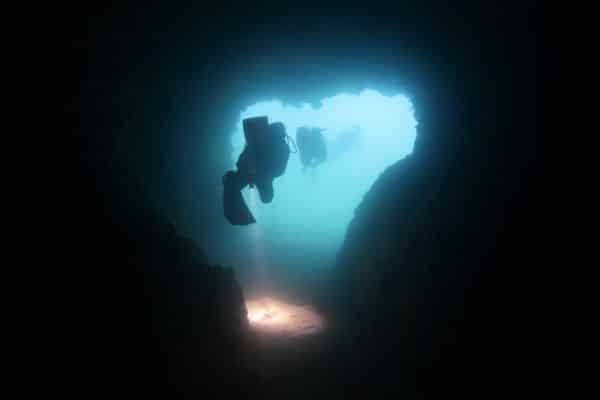
Located approximately 15 minutes from El Nido, Dilumacad Island, also known as Helicopter Island due to its chopper-like shape, is renowned for the underwater tunnel that passes through the island. Discovered by a Japanese diver in the early 1990s, the Dilumacad Tunnel has since captivated divers with its intriguing characteristics.
The dive begins at a depth of 12 meters (39 feet), where the entrance to the tunnel awaits. The tunnel extends for about 40 meters (131 feet) and is characterized by a few ceiling holes that allow light to penetrate, creating an enchanting sight of a school of copper sweepers swimming within the tunnel.
The entrance of the Dilumacad Tunnel is spacious enough for two divers to enter together, setting the stage for an exciting exploration. As divers venture deeper into the tunnel, after around 15-20 meters (49-65 feet), it transforms into a vast cavern, offering a glimpse of the exit ahead. The cavern opens up, providing a panoramic view of the surrounding underwater landscape.
Exiting the tunnel is a more narrow passage, allowing only one diver to proceed at a time. This passage leads to a rocky area with impressive boulder formations extending approximately 20 meters (65 feet) away from the tunnel exit.
It’s important to note that the Helicopter Island Tunnel is suitable for advanced divers only.
2. Entalula Island
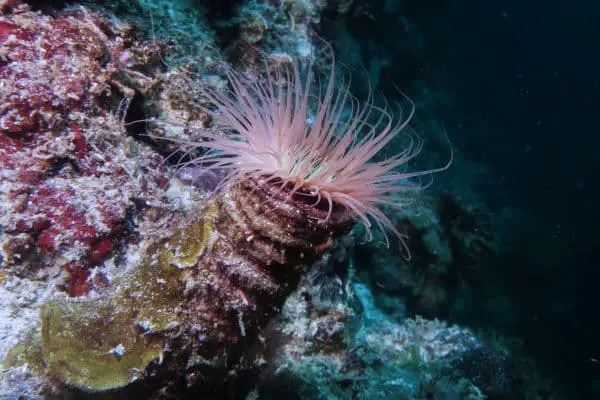
Located south of the famous Miniloc Island, known for its Small and Big Lagoon, Entalula Island is accessible with a travel time of approximately 45 minutes from El Nido town, depending on sea conditions.
The dive site at Entalula showcases a vertical drop-off wall that caters to divers of all levels. With depths ranging from 5 to 30 meters (16 to 98 feet), it offers a range of exploration opportunities. The wall is adorned with a colorful array of beautiful soft corals, whip corals, and sea fans, creating a vibrant and visually stunning underwater landscape.
One of the highlights of the Entalula dive site is the abundance of small inhabitants along its wall. Divers can expect to encounter an array of fascinating marine creatures, including nudibranchs, crabs, pipefish, and shrimps. These intricate and often elusive critters add an element of excitement to the dive, as divers search for hidden treasures among the corals and crevices.
3. South Miniloc Island
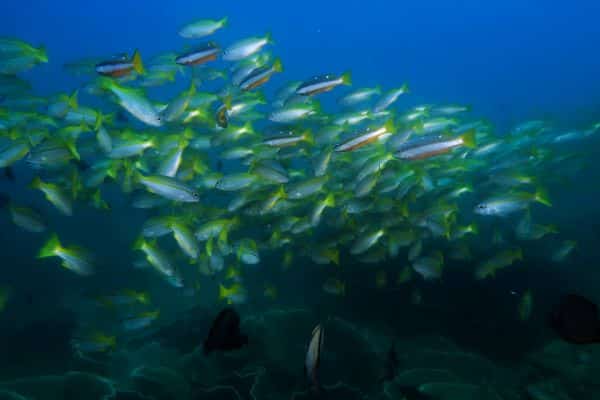
The South Miniloc dive site in El Nido is undeniably one of the most popular and breathtaking dive sites in the area.
The dive site is located between the two islands, Miniloc and Simizu islands. The current that flows here brings a constant supply of fresh nutrients, creating a thriving ecosystem teeming with diverse marine life. While this dive site typically offers calm conditions, occasionally, strong currents can be encountered, making it an exciting destination for experienced divers.
One of the main draws of South Miniloc is its magnificent coral garden and the impressive schools of fish that inhabit the area. The sheer beauty and abundance of cabbage corals and the synchronized movements of the vibrant yellow snappers is the highlight of diving in South Miniloc.
While exploring the depths of South Miniloc, you may also have the chance to encounter pelagic species. Tuna, mackerels, and big barracuda occasionally visit this dive site, adding an element of excitement and the opportunity for memorable encounters with larger marine life.
In the shallow coral garden, divers can discover fascinating critters such as frogfish, ribbon eels, and nudibranchs.
Diving in Sibaltan
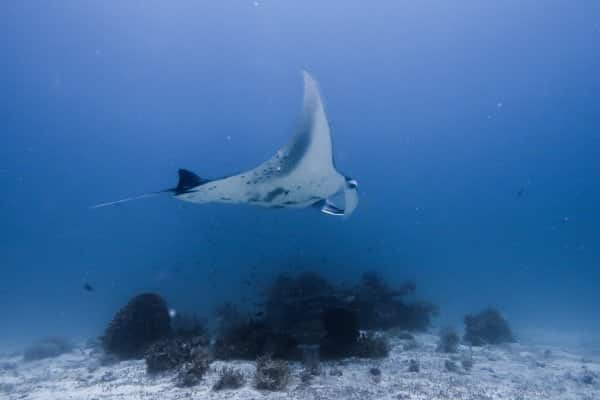
If you find yourself in El Nido, I also recommend making a trip to the town of Sibaltan. Here you can have the opportunity to dive with manta rays. It is a relatively new dive destination, 45 minutes away from El Nido town proper.
Some people do day trips here for a chance to see manta rays in their cleaning stations that are found at 10-13 meters. But I recommend staying for longer as they do have several dive sites that are worth exploring.
Marine Species in El Nido
El Nido diving offers a thrilling and diverse underwater experience, exhibiting the region’s rich marine life and thriving ecosystems. The waters surrounding El Nido are teaming with life, providing opportunities to interact with a diverse range of creatures. A variety of colorful tropical species, including clownfish, angelfish, butterflyfish, snappers, wrasses, and eels live in the coral reefs.
The reefs themselves are a sight to behold, with gorgeous hard and soft corals creating a stunning backdrop for underwater exploration. Divers can also enjoy sightings of beautiful turtles, such as green sea turtles and hawksbill turtles, as they glide through the water or rest on the reefs.
Reef sharks, such as white-tip reef sharks and black-tip reef sharks, have been spotted in El Nido, adding thrill and amazement to the diving experience. Divers may also have the opportunity to encounter pelagic species such as tuna, mackerel, and even manta rays, providing amazing and unforgettable experiences.
El Nido is a treasure mine of microscopic and colorful marine life for macro aficionados. There are nudibranchs, seahorses, frogfish, and pipefish to be found, displaying the exquisite beauty of the underwater environment.
Here are some of the marine life I’ve encountered while scuba diving in El Nido:
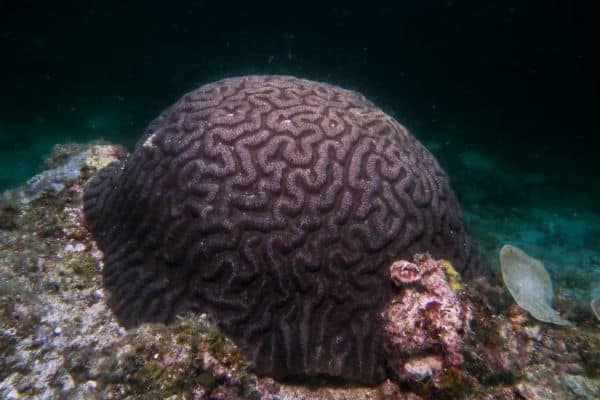
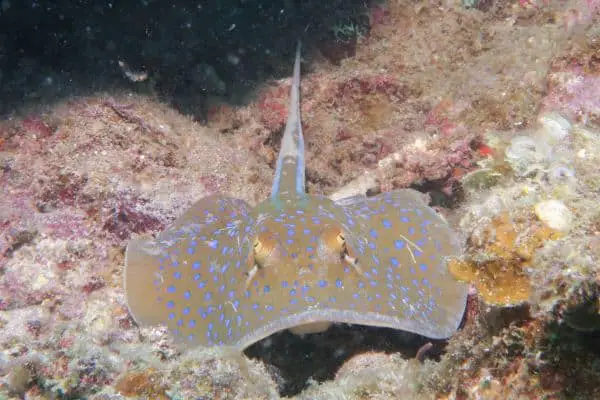
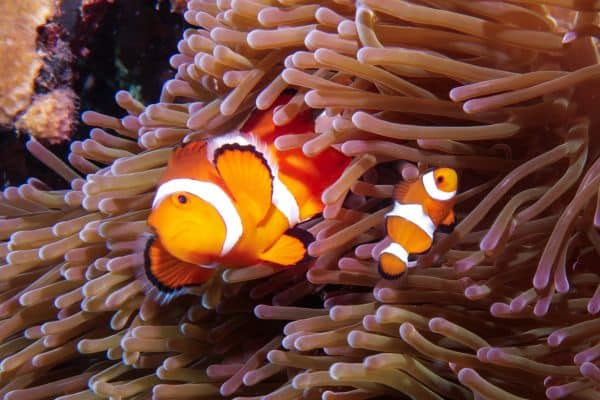
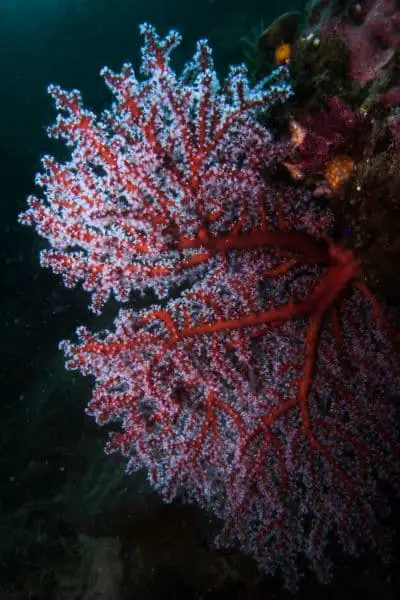
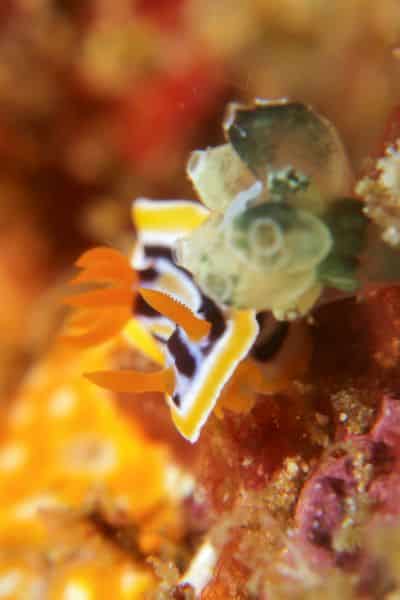
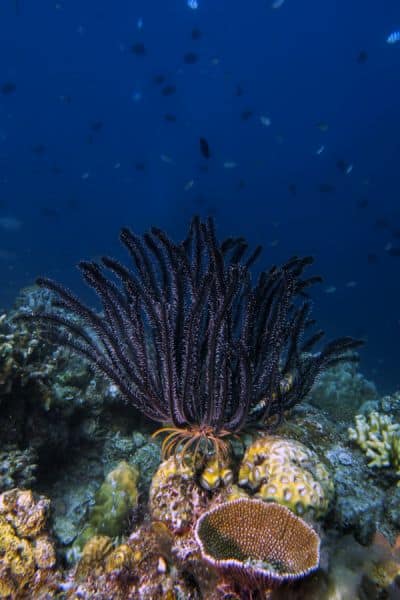
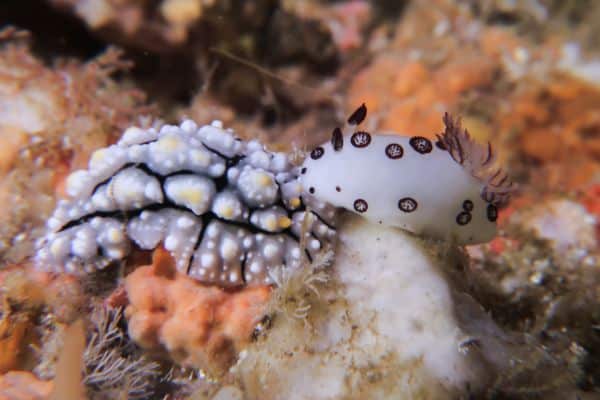
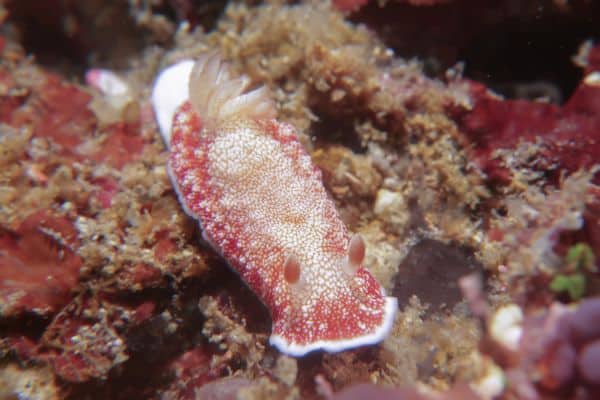
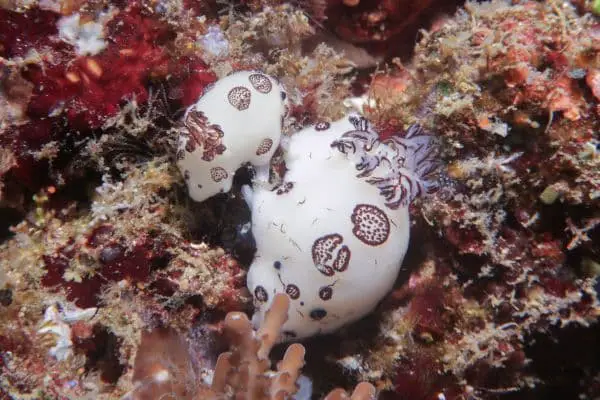
If you’d like to learn more about marine life you might encounter in the Philippines, read these posts:
15 Dangerous Sea Creatures in the Philippines
Marine Life in the Philippines: 100 Sea Creatures You Must See
El Nido Diving Conditions
Water Temperature
The water temperature in El Nido ranges from 24 to 30 degrees Celsius (75.2 to 86 degrees Fahrenheit) throughout the year. A 3mm wetsuit is recommended for most divers. This is a matter of personal preference and tolerance for cold.
Visibility
The water visibility for El Nido diving can vary depending on the season, weather conditions, and dive site. Generally, the visibility ranges from 5-30 meters (16-98 feet), with some sites offering up to 40 meters (131 feet) of visibility on a good day.
The best visibility is usually during the dry season, from March to May, when the water is calmer and clearer. However, even during the rainy season, from June to October, the visibility can still be good at certain sites.
When is the best time to go scuba diving in El Nido?
The best time to go diving in El Nido is from March to May. During these months, the waters are normally calmer and warmer, and the visibility is better. This creates optimal diving conditions and allows divers to completely appreciate El Nido underwater splendor.
It is crucial to note, however, that El Nido is a year-round diving destination, and diving may still be done for the rest of the year. While visibility may be limited during this time, you can still see the incredible marine life that El Nido has to offer.
Recommended reading:
Amihan and Habagat: Diving Seasons in the Philippines Explained
Best Time To Dive in the Philippines + Monthly Guide on Where to Go
Dive Centers in El Nido
El Nido is home to several reputable dive shops. Here are some of the highly recommended dive centers in El Nido:
Palawan Divers
While diving in El Nido, I decided to go with Palawan Divers. It was closest to where I was staying and it also came highly recommended.
From the moment I walked into their organized shop, I knew I was in good hands. The staff were friendly, and knowledgeable, and addressed any questions that I had. They seemed to be a very popular shop so I decided to book right away to secure my spot.
Come diving day, I went to the dive shop at 8 AM where I met my dive group and dive guide, Joel. We had a quick briefing and introduced ourselves to each other, something I appreciated to lessen the awkwardness.
We then walked to the beach where the dive boat was waiting for us. Then we were on our way.
The dive boat was very spacious and had ample space for all 5 of us divers to gear up comfortably. The crew efficiently assisted us in setting up our equipment and made sure we had everything we needed for our dives.
Before each dive, the dive guide conducted a thorough briefing, ensuring that we were well-informed about the dive site, safety procedures, and any specific points of interest. Our guide was very good and even managed to calm down one of the divers who was experiencing some anxiety at the start of the dive.
When we encountered challenging conditions such as poor visibility, he remained vigilant and closely monitored the group, ensuring everyone’s well-being at all times. I always felt safe during the dives.
Lunch was included in the dive package. After two satisfying morning dives, we were treated to a scrumptious spread of local cuisine, including fresh seafood, fried pork chops, chicken curry, rice, and some tropical fruits.
For 3 dives and lunch, I paid Php4,800 to go diving in El Nido with Palawan Divers.
My experience with Palawan Divers was nothing short of exceptional. I now understand why they come highly recommended and why many divers start their diving journey with them. I myself will recommend Palawan Divers to anyone seeking a professional and enjoyable diving experience in El Nido.
You may also check out these dive centers in Palawan:
Turtle Divers
Aquanaut Dive Center
Submariner Diving Center
Tabanka Divers
These El Nido dive centers provide a variety of dive courses, packages, and lodging alternatives to suit every budget and level of diving expertise. These diving shops are ideal for anyone wishing to discover the underwater world of El Nido since they have competent and certified dive instructors, well-maintained dive gear, and a focus on customer satisfaction.
What to Pack for El Nido Diving
Here is the scuba equipment and dive gear I brought when I went diving in Puerto Galera.
My Scuba Diving Gear
Regulator: Scubapro MK25 Evo, C300 and C200 2nd Stage
BCD: Aqualung Axiom
Mask: TUSA M-212 Freedom Ceos
Snorkel: TUSA SP-170 Platina Hyperdry II
Booties: Poseidon Pink Dive Boots
Fins: Problue
Wetsuit: Seavenger
Vest Hoodie: Scubapro Hybrid Hooded Vest
Dive Watch: Suunto D4i Novo
Dive Knife: Aqualung Blunt Tip Knife
Dive Leggings and Rash: Blue Adaptation Coral Sea Fan
My Underwater Camera Gear
Underwater Camera: Canon G7X Mark II
Underwater Camera Housing: Fantasea FG7XII
Video Lights: Big Blue AL1200XP
Underwater Action Camera: GoPro Hero9
360 Camera: Insta360 X3
> Canon G7X Mark II full review
> Insta360 X3 underwater camera review
> Scuba diving camera recommendations for beginners.
Dive Insurance
Divers Alert Network (DAN)


Need travel insurance for your trip? Get a quote from Safety Wing.
Where to Stay in El Nido
There are different accommodations on the island that will fit every diver’s travel style and budget. I usually check Booking.com or Agoda.com for the best deals and promo rates. I stayed in Entalula Bed and Breakfast as it is owned by a friend.
How to get to El Nido
Getting to El Nido, Palawan is an adventure in itself. Here are some common transportation options:
Fly Direct to El Nido
The fastest and most direct way to get to El Nido is by taking a direct flight to El Nido. Air Swift offers daily flights to El Nido from Manila, Cebu, Bohol, Coron, Boracay. The flights land directly at Lio airport, located about 4 kilometers from midtown. At the airport, tricycle drivers will be waiting for you and it will take around 20 minutes to get into town. You can also check with your accommodation to see if they can organize a private pickup for you.
Via Puerto Princesa
From Manila or Cebu, you can fly to Puerto Princesa via Air Asia, Cebu Pacific, or Philippine Airlines. Then make your way to San Jose Terminal in Puerto Princesa and take a shared van that can take you directly to El Nido. You can also check getTransfer.com if you prefer to travel in a private vehicle with a driver. The journey from Puerto Princesa to El Nido will take 5-6 hours.
Via Coron
From Coron, it is possible to get to El Nido via ferry. The journey takes approximately 4 to 5 hours, depending on sea conditions and the type of vessel. It’s advisable to book your ferry ticket in advance, especially during peak seasons, to secure your seat. The fare is around Php 2640 one way.
